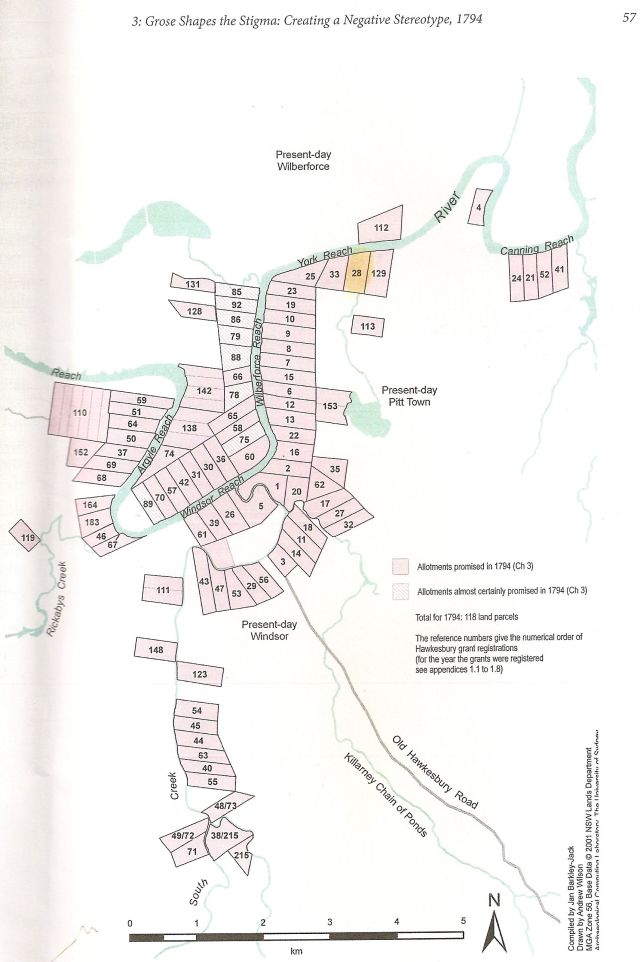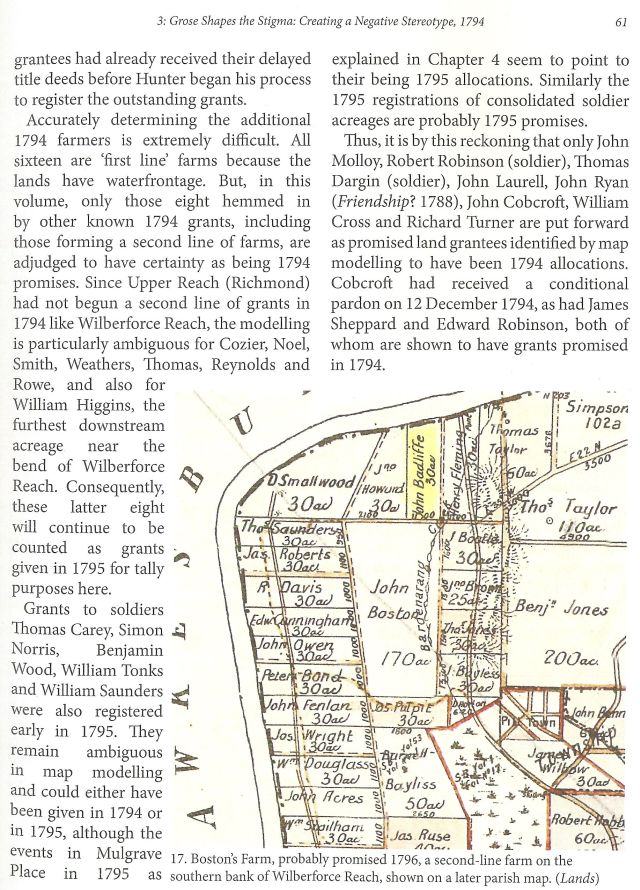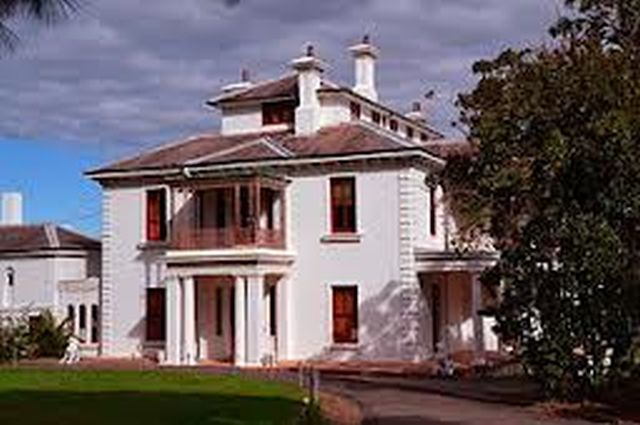
1799
[PRO HO 11/1, p.255, Reel 87]
Thomas Bradshaw - convicted - Warwick Assizes, 31 March 1798, sentenced for life
Arr. Sydney, Hillsborough, 26 July 1799.
No subsequent record. Quite probably died soon after landing, as did a number of prisoners from this "fever ship".
Who could imagine the settlement of Sydney with what it is today?
As a "free" settler, Elizabeth would have been given a land grant. To build a house, Elizabeth would have been granted land. That land was in a most desirable location.
The building would have been only built with wattle branches, just strong enough perhaps to protect her and her young daughter from the elements. Mary Ann was only 2 years old.
As there were no houses, nor shelter, it is reasonable to expect that Elizabeth would have been given a convict (ward) to help her build some sort of house.
So where does Robert Jillett fit into this cosy picture?
Unfortunately Thomas Bradshaw either died before landing, or after landing in Sydney Cove. He had been sick on board the Hillsborough, and was nursed by Elizabeth, as described by the convict Noah in Frank Mc Clune's book. No records are available about Thomas. Many of the poor souls that arrived were far too sick to even make it off the boat. Some just slipped into the water, never to be seen again.
None of them had any clothing when they arrived, as is described in the letters written by the Colonial Secretary to London.
As a free settler, Elizabeth would have been granted a convict. So Robert Jillett obviously was in her charge. They soon became a couple.
She bore two sons in Port Jackson, William and James, both who took her name only. That was the norm within the colonies, if children were born to unmarried mothers.
Elizabeth made a life for herself, as a business person. She had her property in Chapel Row, and a boat with which she plied the Hawkesbury River.
Elizabeth owned land in Sydney, as written in the book Scallywags of Sydney Cove, by Frank Clune.
"On 18 April 1803 he (HB Hayes) paid Elizabeth Bradshaw £27.7.0 for a house lately occupied by Robert Gillet, situate in Chapel Row, Sydney, also a boat on the stock" These records can be found in the Archives, she also purchased in March 1803 a property known as Badlife Farm, in the Hawkesbury region. It was originally granted to John Badlife, a convict, who sold it to another convict before he sold it to Elizabeth for £150.
That was an enormous amount of money in those days, and poses the question "why did Robert need to steal if she had that much money"?
Elizabeth was one of the Pioneers of the Hawkesbury region, her lands were located in what is now the Ku-ring-gai Chase National Park.
Further information can be found in the book Hawkesbury Settlement Revealed.
A PIONEER OF THE HAWKESBURY!
1802
MUSTERS AND LISTS FOR NEW SOUTH WALES AND NORFOLK ISLAND, 1800 - 1802.
List of Expired or Emancipated Convicts and Free People, off the stores in 1801.
Ref. No. AE070, Ship Hillsborough, Elizabeth Bradshaw, resident at Sydney, Ticket No. 066, arrived free.
[No reference to Robert Jillett in convict lists. Possibly under his alias, ELSTON
but more likely that serving convicts were excluded from these lists].
[Notes: - The original name Chapel Row was changed first to Camden Street, then by Governor Macquarie in 1810 to Castlereagh Street.
Sir H. B. Hayes later built Vaucluse. He was the holder of a Ticket-of-Leave, issued February 2, 1803, and was the subject of correspondence of Governor Hunter, mainly in connection for his involvement in organising unauthorised Freemasons Lodge meetings.
- after Elizabeth Bradshaw and Robert Jillett transferred to Norfolk Island, the Little William continued to trade between the Hawkesbury and Sydney. She arrived on Saturday 18th August, 1804 with a load of maize and after weathering a storm was moored to a stump in Cabbage Tree Bay.]
In 1803, Robert Gillett (Jillett) was convicted of stealing half a side of pork from the Commandant stores. He was found guilty and sentenced to death. As he prepared to face the hangman's noose, a rider came with a pardon. He was resentenced to spend his time on Norfolk Island.
Poor Elizabeth, how did Robert get a reprieve? Did money pass hands? As a business woman, did she pay?
We may never know as the original paper is not able to be located at the Mitchell Library.
Elizabeth then immediately advertised her property and the boat for sale in the Sydney papers. so that she could travel with Robert on the SS Buffalo.
The NSW Archives indicate that Elizabeth sold land in Chapel Row and a boat to Sir Henry Hayes, and that she sold a house & baking trough in Chapel Row to Thomas Brooks
Hayes took up residence in Chapel Row, Sydney. He purchased the property which he called 'Vaucluse' on 22 August 1803. The first published notice of the name Vaucluse is in an advertisement in the Sydney Gazette, 29 January 1804.
The Windsor and Richmond Gazette of 4th August 1922 mentions that a selection of 60 acres, known as Cavanaugh's Farm was sold by Elizabeth Bradshaw, to Thomas Chaffey for 43 pounds, in trust for his son Zachariah Chaffey, on 31st August 1802.
Note: The original name Chapel Row was changed firstly to Camden Street, then by Governor Macquarie in 1810 Castlereagh Street. Her land holdings were from Castlereagh Street to the site of Vaucluse House.
What would that property be worth in today's monies?
Sir H.B. Hayes later built the dwelling known as Vaucluse House.
"RASCALS, RUFFIANS & REBELS" of early Australia by Frank Clune, [Angus & Robertson] ISBN 0207 15666.2 Chapter 13 Sir Henry Browne Hayes (Irish convict) with reference to Elizabeth Bradshaw & Robert GILLETT (sic) & sale of property- see page 151.






Details and map of John Badlife's farm on the Hawkesbury!







